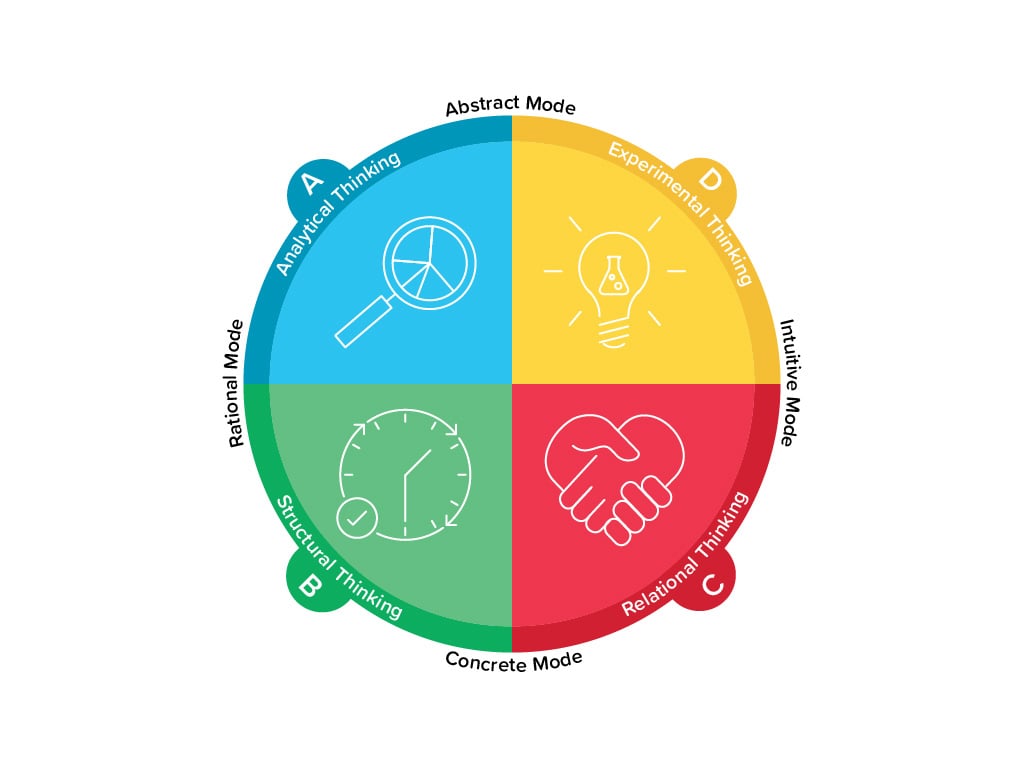According to the Whole Brain® framework, workers who prefer experimental and analytical thinking styles tend to be more rational. They take a more logical and cognitive approach to problem-solving, using facts, figures, and statistics to guide their decision-making, rather than relying on gut instinct or intuition. Rational thinkers tend to be more organized than intuitive thinkers, and they may feel uncomfortable with chaos or ambiguity. So when it comes to handling stress – whether that’s a heavy workload, unrealistic timelines, a lack of support, or workplace culture – rational thinkers will react and respond differently to someone who is guided by their emotions. For rational thinkers, managing stress and decision-making under pressure is all about structure, certainty, and transforming the complex into the simple.
Where does the rational thinker sit on The Whole Brain® Model?
 Those who tend to be more rational sit on the left-hand side of the Whole Brain® Model. The model suggests that these rational minds are more analytical and practical in their thinking preferences. Unlike those whose preferences align with the right-hand side of the model, analytical thinkers are fact-based and logical, while practical thinkers are organized, and prefer methodical and sequential approaches to decision-making. These characteristics impact how rational thinkers react to stress and pressure.
Those who tend to be more rational sit on the left-hand side of the Whole Brain® Model. The model suggests that these rational minds are more analytical and practical in their thinking preferences. Unlike those whose preferences align with the right-hand side of the model, analytical thinkers are fact-based and logical, while practical thinkers are organized, and prefer methodical and sequential approaches to decision-making. These characteristics impact how rational thinkers react to stress and pressure.
How does a rational thinker handle stress at work?
In times of chaos, the analytical thinker wants action, and they’ll need facts, data, and research to drive any decisions they make. Analytical thinkers need absolute clarity on the goal and purpose of whatever they’ve been tasked with – don’t clutter their to-do list with tasks if you can’t provide a rationale for why they should take them on. You might think you’re helping them deal with a heavy workload by prioritizing one task over another, but if you can’t provide the rationale as to why that job should be prioritized, you’ll only stress them out more. Similarly, the practical thinker needs order, rules, details, and comprehensive plans. In times of stress, they need the space to focus on the most critical aspects of a job or issue. They also need absolute clarity on timeframes and expectations. Together, these rational thinkers tend to seek out certainty and safety when the pressure is on. In the midst of chaos, or when they’re feeling stressed, they need facts, data, and an opportunity to focus singularly on the issue at hand. They need clarity on roles, goals, and expectations. They may be less holistic in their perspectives, struggling to see a big-picture reason for why the pressure is so intense, and they may come across as being insensitive to the emotions of others. They’re not being malicious – they just prefer to rely on data rather than humans during stressful times.
How to help your employees reduce stress in the workplace
The first step to helping your employees handle stress is to recognize, understand and engage with those employees in a language they’ll understand. Once you can identify what’s important to the rational thinker, you’ll be able to help them tackle any issues or workplace pressure head-on, helping them find clarity and safety amidst the chaos. It’s about identifying what information these thinkers need to feel safe. The Whole Brain® Thinking framework gives you the skills to recognize the rational mind and adapt your leadership style to better lead them through times of stress. For the rational thinker, it’s all about the details. They’ll take comfort in comprehensive plans that are well-researched, well-thought-out, and that is backed up by data, facts, and clear rationale. Make sure these workers know what their role is and what the expectations are. Rational thinkers need time and space to deal with a stressful situation in a methodical way. Don’t overwhelm them with too many tasks, or an overarching vision. Instead, help them break complex problems into manageable projects that they can work through one step at a time. When the pressure is on, rational thinkers need to feel secure, and that means clear expectations, comprehensive plans, and supporting data.












